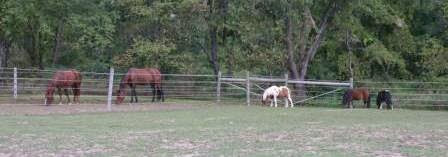In talking with the bank executive - we'll call him Tom (not his real name) - he shared with me that the thing that stood out most to him in
working with the horses was how integral trust was in getting the horses to
work with the leadership team. Tom was
working with two other people to move three miniature horses from one area of
the pasture to another. They were given
2 minutes to develop a plan, but after that they were not allowed to touch the horses or
talk to each other during the project.
The group approached the horses with a commanding presence and the
horses responded by running away. The
group continued to approach the horses in a way that communicated “You are
going to do this whether you want to or not.”
The horses continued to choose not to go where the group was asking them
to go. After about 10 minutes, the
facilitators checked in with the leadership team to see how things were going
and talk about what was happening.
Through the discussion, the horses were compared to a team of employees. The group realized that they were approaching
the “team” with too much command and control style of leadership and not building the trust that was needed to lead the team.
The group was given another opportunity to guide their “team members”(horses) to the area where they needed to be. This time they were allowed to talk to each other but still not allowed any kind of tools to physically attach to the horses to move them. And this time, they approached their “team members” with a different kind of intention. Instead of walking towards the horses with command and control leadership, they took time to build trust with each team member, communicating in a way that was respectful to them as individuals. The result? The team members willingly went with the leaders where they wanted them to go.
So how does this work with the horses apply to leadership in
the human world?
- Trust comes from respect. Almost every leadership book, blog and article talks about trust as the key characteristic of an effective leader. In their book The Leadership Challenge, Kouzes and Posner (2007) note that “Without trust, you cannot lead” (p. 224). They go on to state that “We listen to people we trust and accept their influence” (p. 225). Once the leadership team built trust with the team members (horses), they were able to influence them to move where they needed them to go, with minimal effort.
- Leadership is about relationships. Kouzes and Posner hit the nail on the head when they write “A leader-constituent relationship that’s characterized by fear and distrust will never, ever produce anything offering value. A relationship characterized by mutual respect and confidence will overcome the greatest adversities and leave a legacy of significance” (p. 24). For this leadership team, the command and control approach with the team (horses) was highly unproductive. When they took the time to build a relationship with each team member, mutual respect was established and the team willingly followed the leaders.
- Command and control does not build relationships or trust. How much do you like someone who leads you using a command and control leadership style? Probably as much as the horses. The horses respond by not cooperating – this is usually what happens with people too. Command and control might work temporarily, but long term it will only create an environment where team members avoid cooperating whenever they have that option.
Kouzes and Posner note that “People are just more willing to
follow someone they like and trust” (p. 295).
When people work with the horses in our action learning program, they are able to literally see how
they are influencing others. The horses willingly
follow when participants take the time to build trust through
relationships and intentions are honest. What kind of
relationships are you building? Are your
team members running around the pasture or willingly following you where you
need them to go?
Ginny Telego is the president and founder of Wager's Way,
an equine assisted action learning program that partners with horses to offer
leadership and team development as well as executive coaching. Find out more at www.wagersway.com.

